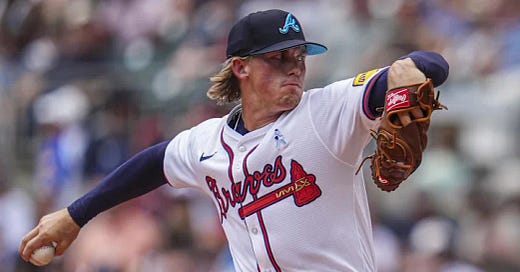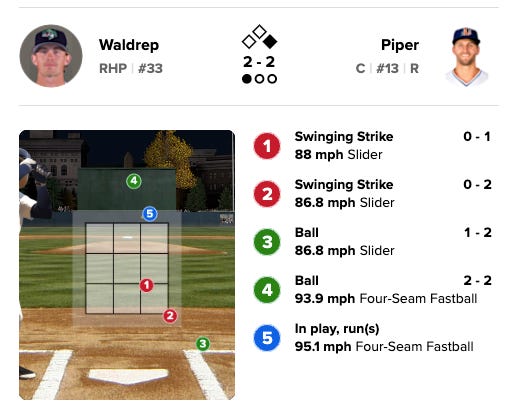Did Hurston Waldrep completely fix his issues with one simple trick?
Waldrep's mechanical changes he showed on Thursday has the potential to be a gamechanger for Atlanta's rotation depth down the stretch
Hurston Waldrep’s been the organization’s poster child for “stuff doesn’t matter if you don’t know where it is going.”
Drafted out of the University of Florida in 2023’s first round, Waldrep’s featured a devastating splitter and backed that up with a 95 mph fastball and both a slider and a curveball. The one issue he’s had to this point in his career is the fastball combines several issues: A bad shape plus an inability to reliably throw it for strikes.
On Thursday night in a Triple-A start against Durham, Waldrep made a mechanical change that appears as if it may have turned the page for the talented righty.
Let’s talk about it.
Walks have always been an issue for Waldrep
In his collegiate career, spread between two years at Southern Mississippi and one at Florida, Waldrep walked 98 of the 892 batters he faced, good for a 4.2 BB/9.
That didn’t get better in the minors.
Entering last night’s start, Waldrep had a 4.9 BB/9 in Atlanta’s minor league system plus another eight walks in just seven major league innings last year. While the overall ERA was okay, with a career 3.65 in the minors, it’s not been for lack of opportunity on the part of opposing offenses: Waldrep’s career WHIP was 1.517.
That’s right, he allowed three baserunners every two innings.
A lot of this stems from the fastball. A four-seamer with significantly below-average induced vertical break, it suffered from both poor locations and the dead zone shape. Let’s take these one at a time.
Here’s the location of every Statcast-tracked fastball he’s thrown entering last night’s start, 461 total pitches:
Statcast is only publicly available for Triple-A and select Florida State League (Single-A) parks.
Does it look like he doesn’t entirely know where it’s going? Because that’s been the case - in the minors, the fastball was in the zone just 43.4% of the time last season.
For context here, the MLB average for zoning a four-seam fastball is 56.04% this year.
And even when it was in the zone, the shape of the pitch wasn’t ideal. From a movement perspective, the induced vertical break of the fastball was about 13.6 inches. An above-average number is considered to be 18 inches, where 20+ is elite and anything below about 16 is considered below-average without significant horizontal movement.
Every four-seam fastball moves horizontally, but the amount of movement heavily determines the effectiveness of the pitch. Waldrep gets just 4.7 inches of horizontal movement, too much to fall into the realm of a cut fastball but not enough to be a running fastball, which is typically more than 12 inches and can get up to 20.
The result of this is what’s called a “dead zone” profile - in essence, the fastball moves exactly like a hitter expects it would, allowing them to better anticipate its trajectory and make solid contact.
So, to recap: It’s a fastball that both doesn’t have enough backspin to get someone to swing under it, but also not enough horizontal movement to fool hitters and/or shift contact off of the barrel of the bat.
Oh, and he couldn’t really locate it that well, meaning that hitters could mostly ignore the splitter because there was no threat of the fastball getting you behind in the count.
That is, until last night.
He made a mechanical adjustment
Pre-draft scouting reports referred to “effort in his up-tempo delivery” that caused control and command issues that ticked his walk rate up in his draft year. One detailed mechanical breakdown went into further detail about what caused his issues.
The significant tilt in his shoulders produces a high over-the-top arm slot and he struggles with command and control at times, with a violent movement of his head off to the side and some closed-off recoil in his finish. The side-head lean causes him to miss high and arm side when he’s out of sync and late.
All of this comes back to his leg kick, which is rather pronounced and one of the bigger leg kicks in the system. Here’s a shot of him in college:
See how the knee is up at glove level? Wild.
He’s fixed that.
After a disastrous start last week, with two hits and three walks in less than one full inning that had us openly questioning whether or not the org would go ahead and pull the plug on the starting experiment, he’s adjusted.
As first noticed by Guarav Vedak from Baseball Prospectus and Peach State Prospects, here is Hurston’s leg kick today:
See how it’s a lot more subdued of a movement and being more under control allows him to finish more upright? It’s a sign that he’s not wasting excess energy on lateral movement, able to gather and deliver to the plate on a straight line.
While the overall fastball zone percentage wasn’t exceptional in this outing, it was more reliable early in counts and he was able to get ahead of batters with the heater and then play the splitter/slider off of that.
In this outing, Waldrep went a season-long 5.1 innings with only two runs allowed on two hits, walking two and striking out ten. Both hits and runs came in the fifth inning, with a single followed by a home run.
(And honestly, it’s frustrating to give up a homer on this pitch but that’s baseball)
Courtesy of Guarav (go listen to Peach State Prospects, seriously - some of the best breakdowns on Braves prospects you’ll find anywhere), here are a few more videos of Waldrep from Thursday.
Full at-bat against Carson Williams, a consensus top ten prospect in baseball.
Here’s a side-by-side from earlier this season (left) and tonight (right) - the reduced leg kick and cleaner finish is very evident.
And here’s after some fatigue has set in, coming later in the 4th inning, and he’s started to drift a bit into some bad habits with old mechanics.
Stuff was still effective, though; this was his 8th strikeout and he picked up two more after this before finally leaving the game.
If this is something that can stick with Waldrep, it changes the conversation about the Splitter King. He goes from someone that is destined to be in the pen to someone that can get back into the starting mix, potentially as early as the back half of 2025.






G, a long time Twitter friend of mine, getting a shoutout on my favorite Braves outlet? The crossover I didn't know I needed.